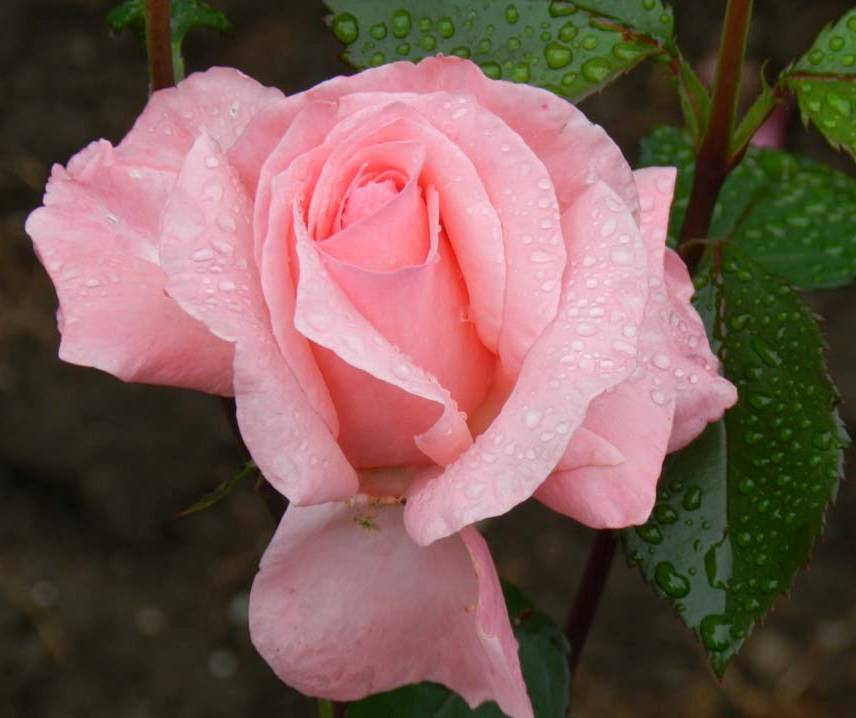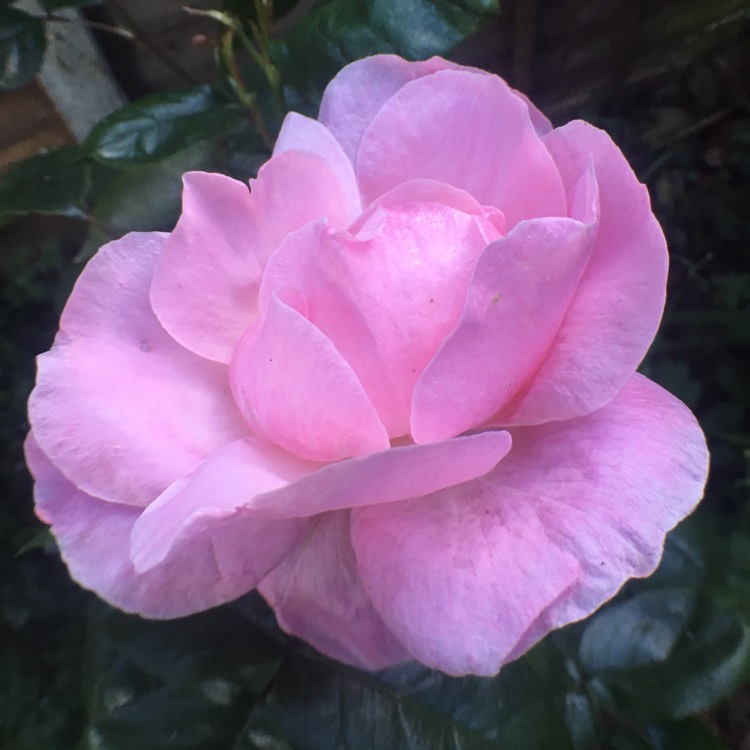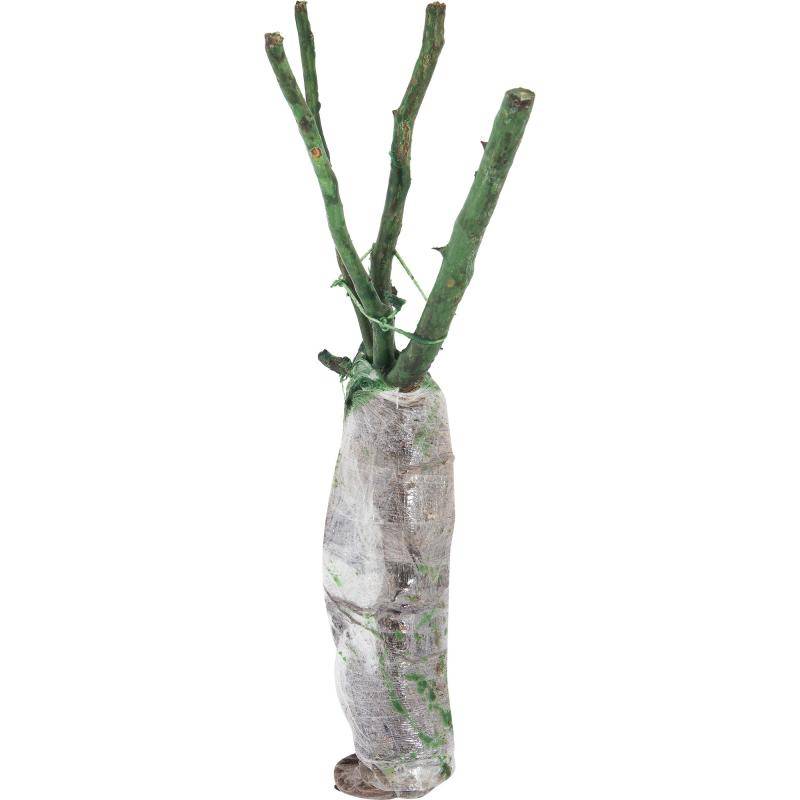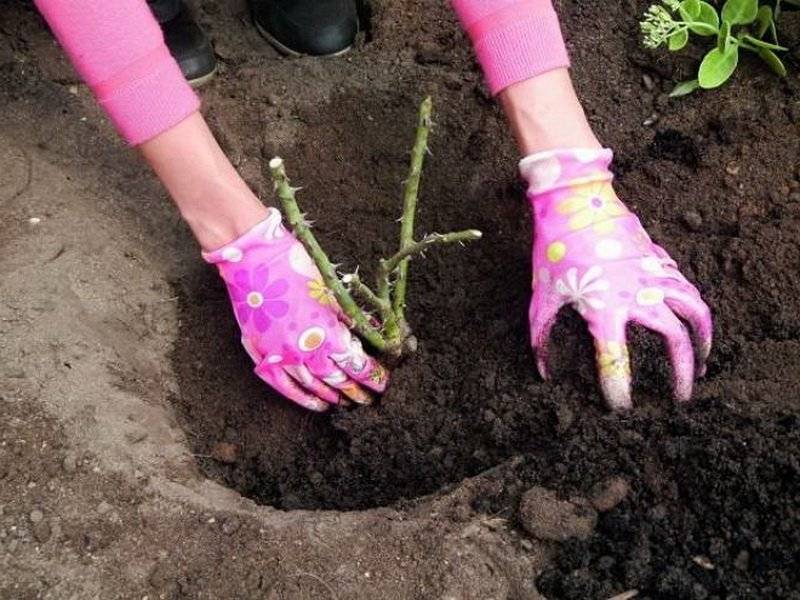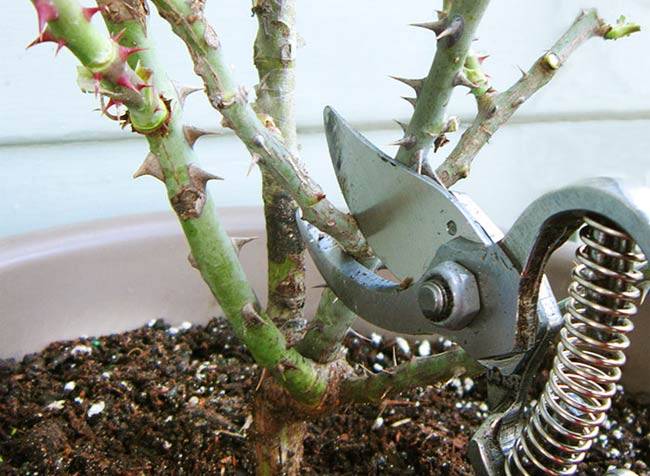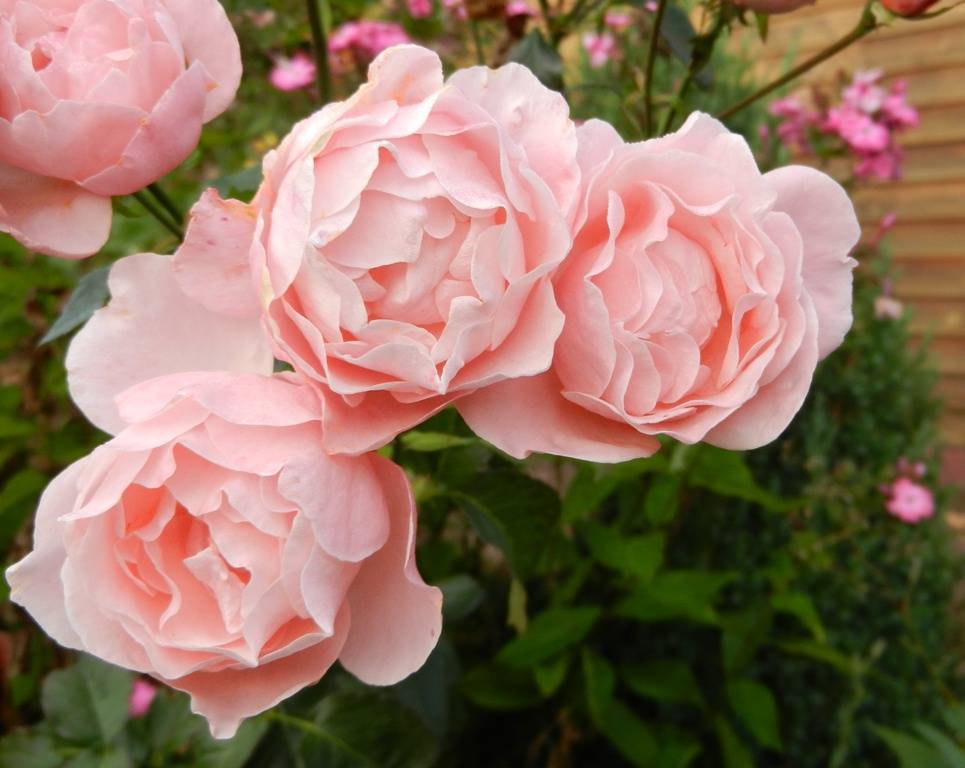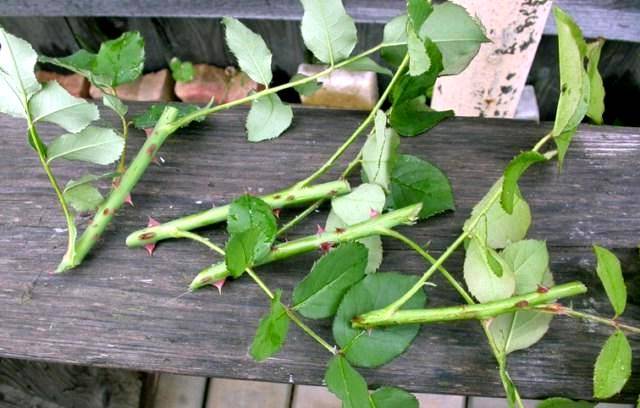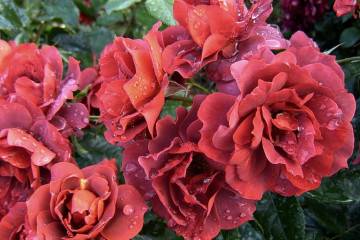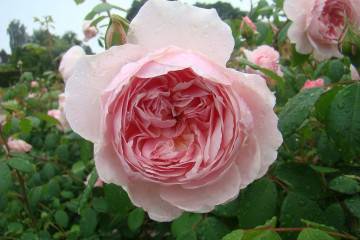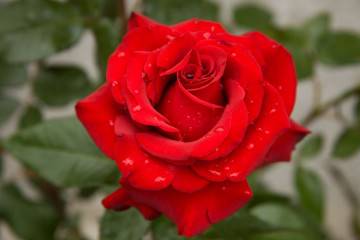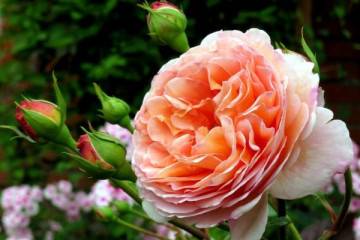Rose Queen Elizabeth (Queen Elizabeth) - description of a varietal plant
Content:
Rose Queen Elizabeth has been known to flower lovers for about seventy years, but still enjoys well-deserved popularity. The unpretentiousness and endurance of the variety, abundant flowering throughout the season determine the widespread distribution of the plant in private plots, when decorating the design of parks and squares.
Rose Queen Elizabeth (Queen Elizabeth) - what kind of variety, history of creation
The rose was bred by American breeder Walter Lammerts in 1954, and was named after Elizabeth, who ascended the royal throne in 1952. The cultivar was obtained by crossing the varieties Charlotte Armstron and Floradora. From the hybrid tea group, the rose inherited the height of the bush and large flowers. From floribunda roses - carpal inflorescence, unpretentiousness and frost resistance. Rose has won numerous awards in the United States and other countries around the world.
Brief description, characteristic
Rose Queen Elizabeth - reaches a height of 180 cm, the plant is compact, the stems are low-thorn, not spreading. Young shoots are attracted by a red color, adult foliage is glossy, bright green in color.
Flowers of pale pink color, 8-10 cm in size, are collected in carpal inflorescences of 5-15 pieces. The buds are beautifully shaped with a high center. The opened flowers with a wavy edge of the petals have a goblet shape, over time they become flatter. Double flowers have 25-35 petals. The rose has a weak aroma.
Advantages and disadvantages of the variety
Rose Queen Elizabeth of the floribunda group is distinguished by increased endurance. It winters well in the middle zone, even with little cover. During snowless winters, the aerial part may freeze out, but the flower has a high regenerative capacity, it quickly recovers due to the basal buds located above the grafting site.
The variety is distinguished by the splendor of flowering, with good care it releases more than 10 stems with buds at the same time. Repeated flowering, with short interruptions. Roses on high peduncles are suitable for cutting.
Rose Queen has practically no flaws. The flower needs a step cut, if this is not done, the lower part of the bush looks bare.
Use in landscape design
Rose Queen of England looks great when planted alone as an accent plant, and among roses planted by a group. Roses look especially good against the background of a mown lawn and in compositions with conifers.
Growing a flower, how to plant it in open ground
Rose seeds are rarely grown. The seed must be stratified in cold conditions, the seedlings bloom 3-4 years after planting.
In what form is the landing
In specialized stores and nurseries, it is easy to purchase a grafted seedling. Floribunda roses are sold with open and closed root systems in containers. When choosing a seedling, you need to pay attention to the appearance of the plant. The stalk must have intact green bark and a branched root system. The root collar (site of inoculation) should be 5-8 mm in diameter.
What time is the boarding
The time for planting rose Queen in open ground depends on the climatic conditions of the region. In central Russia and the Moscow region, seedlings with an open root system are planted from April 20 to the end of May. When choosing the planting time, the weather forecast is taken into account: if frosts are expected, the plant is planted at a later date.
Cuttings with a closed root system can be planted during May-June, when the weather is warm. Plants in containers can be planted throughout the growing season. Autumn planting of roses is successful only in the southern regions of the country. In regions with a harsh climate, there is a risk of freezing out of an incompletely rooted bush.
Location selection
The rose loves to grow in lighted areas with light shade in the afternoon. When planted in shady places in the garden, the rose blooms little, gets sick with powdery mildew and other fungal diseases. The landing site must be protected from the winds.
How to prepare the soil and flower for planting
If the garden area has heavy soil with a high clay content, humus and compost are introduced into the soil a year before planting the seedlings. By decaying, organic matter will improve the structure of the soil. In places where water stagnates, you need to install drainage or arrange high beds.
Before planting, the seedling is examined, dried stems and diseased dark roots are cut off, shortened by 5-8 cm. If the root system is dry, the cutting is soaked for a day in a clay mash.
Planting procedure step by step
In the prepared section of the garden, a planting hole is dug 40 cm wide and deep. The top fertile soil layer is removed, put aside. The bottom layer is not needed. Move fertile soil with 2 kg of humus and 1 tbsp. l. fertilizers for flowering plants.
Step-by-step instructions for planting a seedling:
- Spill the hole with water.
- Pour half of the fertile mixture into the pit, form a mound.
- Place the seedling in the center, distribute the roots evenly on the sides of the hill.
- Cover the cutting with soil mixture, the root collar should be 3-5 cm deep.
- Gently compact the soil.
- Water the seedling abundantly around the edges of the hole (not at the root);
Mulch the trunk circle with peat, sawdust or expanded clay.
Plant care
Proper care includes regular watering, feeding, weeding and loosening, disease and pest control
Watering rules and humidity
Rose loves abundant watering. In cold weather, the flower is watered once a week at the rate of 1 bucket of water per bush. During a drought, the number of waterings is increased to two per week. The plant does not tolerate the drying out of an earthen coma, the soil surface should always be moist.
Since August, the number of waterings has been reduced. In autumn, the plant has enough atmospheric precipitation, excessive humidity leads to the appearance of young shoots that do not have time to ripen.
Top dressing and soil quality
The flower needs regular feeding. If the soil where it grows is rich in humus, fertilizing with mineral fertilizers is enough. When growing a flower on scarce soils, organic and complex mineral dressings are combined.
Fertilizers are applied:
- 2 weeks after spring pruning;
- during the budding period;
- after flowering.
Pruning and replanting
Pruning roses Elizabeth is carried out three times a year:
- At the end of March, before the start of sap flow, 3-5 shoots are left. 2-3 buds are left on strong trunks, 1-2 buds on weak ones.
- In the middle of the season, stimulating pruning is performed. The shoots are shortened by a few cm to stimulate the emergence of buds.
- Autumn pruning takes place in September. Weak and diseased shoots are cut, the plant is shortened to a height of 25-30 cm.
Shrub transplant is carried out in the spring. A planting hole is prepared as when planting, the plant is dug up, diseased roots are removed. The root system is shortened to 20-25 cm and planted at the same depth. Water abundantly, trying to pour water not at the root.
Features of wintering a flower
Rose Elizabeth needs shelter for the winter. In the fall, the plant is spud, sanitary pruning is carried out, and plant residues are removed. Sprinkle the trunk circle with peat to a height of 20-30 cm.
Blooming rose
The Queen Elizabeth rose is one of the most beautiful floribunda roses. Delicate pink flowers are located on tall peduncles.
A period of activity and rest
The first wave of flowering occurs on last year's shoots. At this time, young red shoots grow up. In summer, buds are formed both on last year's and on the stems of the current year. The rose blooms from June to September with short breaks. It is recommended to remove the last buds to allow the plant to prepare for winter.
Care during and after flowering
During the budding period, the plant is fed with fertilizer for flowering plants. Regular weeding is carried out with loosening to a depth of 10 cm. Timely pruning of wilted flowers stimulates the plant to new bud formation.
What to do if it does not bloom, possible reasons
The rose does not bloom after an unsuccessful wintering, with improper care, damage from diseases or pests. Top dressing with phosphorus-potassium fertilizers can provoke the appearance of buds.
Flower propagation
Rose Queen Elizabeth from the floribunda group is easy to propagate by cuttings. The best time for cutting cuttings is early-mid July, after the end of the first wave of plant flowering.
Suitable for reproduction are semi-lignified green cuttings, which are best taken from lateral shoots. The lower cut is made obliquely, 2 mm below the kidney. The upper cut is horizontal, 0.5-1 cm above the bud. The stalk should be about 10 cm long, contain 2-3 internodes. The lower leaves are removed, the remaining 2-3 leaves are shortened by half.
Description of the process of planting cuttings:
- The planting material is soaked for 2-3 hours in a Heterauxin solution (40-45 g per 1 l of water).
- They are planted in a loose substrate consisting of turf soil, peat and sand, at an angle.
- The plantings are covered with polyethylene, shaded from the sun.
- Spray and watered several times a day.
If it is impossible to constantly care for the plantings, the cuttings are placed at home in a jar of water. After two weeks, a characteristic influx will appear on the lower cut. Such cuttings root easily in the substrate.
Diseases, pests and control measures
Roses are susceptible to fungal and viral diseases. Diseases that affect roses most often:
- Powdery mildew - appears on bushes in rainy years, with sudden changes in temperature.
- Spotting is a group of diseases affecting plants with increased temperature and humidity, lack of trace elements in dressings.
- Gray rot (botrytis) - weakened plants get sick in wet weather.
For prophylaxis, roses are sprayed during the entire growing season with a solution of "Fitosporin" every 10-14 days. In early spring and autumn, the bushes are sprayed with a 1% solution of Bordeaux liquid.
The main plant pests: green aphids, thrips, leaf rollers. With a small number of harmful insects, folk remedies with a deterrent effect are used. In case of severe damage, contact insecticides of a wide spectrum of action are used - "Inta-Vir", "Iskra".
Rose Queen Elizabeth Floribunda can be recommended for breeding beginners. Due to its unpretentiousness, the flower rarely disappoints beginner growers, annually pleases with abundant flowering.
